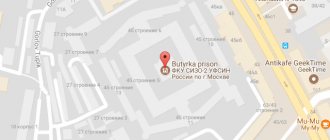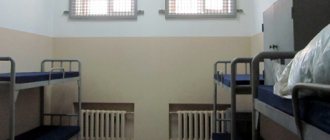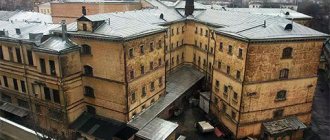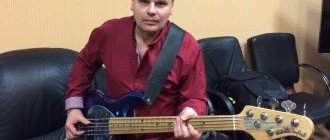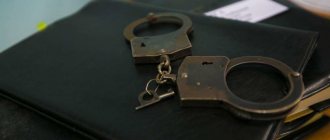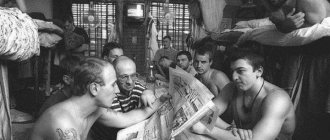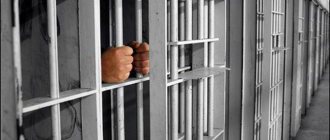general information
- Number of seats: 1220.
- Head of the prison: Alexey Nikolaevich Klimov.
- Phones:
Duty department.Fax - 9.
- What schedule are parcels and letters accepted on?
Monday through FridayApplications are accepted from 8.00 to 12.00.
Reception of transfers - from 10.00 to 15.00.
Short-term visits are provided from 10.00 to 16.00.
- Official website: www.33.fsin.su/structure/t_2_vladimirskiy_tsentral.php
- Official name: T-2 Vladimir Central.
- Address: Russia, Vladimir region, Nizhny Novgorod Bol. st., 67.
Prison on the map:
Address and contacts
- Address. The actual address of the correctional institution is as follows - Vladimir region, city of Vladimir, Bolshaya Nizhegorodskaya street, building 67. Index - 600020. It is to this address that letters and parcels can be sent.
- Prison administration telephone numbers: (4922) 32 53 16.
- Email address -
- Vladimir Central Prison on the map of Vladimir:
- The working hours of the correctional facility are from 8 a.m. to 6 p.m., break from 12 p.m. to 1 p.m. Every first Sunday of the month is a sanitary day.
- Management. The head of the institution is Colonel I. N. Kulagin. The deputy heads of the prison are majors of the internal service A. S. Vasiliev, A. V. Makarov, A. Yu. Emelyanov, Lieutenant Colonel S. V. Treshchalov. The head of the medical and preventive unit is Captain N. G. Blaga. The head of the Center is Lieutenant Colonel E. N. Sviridov.
- Official name of the institution. Vladimir Central is the unofficial name of the institution, which comes from the location of the colony (in Vladimir) and the central purpose of the prison (abbreviated as central). Officially, the prison is named after FKU T-2 of the Federal Penitentiary Service of Russia for the Vladimir Region.
Why is the prison called "Black Dolphin"? Find out the answer right now.
Photo
The following are photos of the prison “Vladimir class=”aligncenter” width=”800″ height=”534″[/img]
Reception schedule for citizens
For any contact with prisoners, as well as for receiving applications and parcels from relatives, there is a certain routine :
- Applications are accepted on weekdays from 8 to 10 am.
- Reception of programs is carried out on all days except Sunday and Monday, from 10 to 16 hours. Transfers are issued on the same day from 16 to 17 hours.
- Short-term visits with prisoners are carried out on weekdays from 8 a.m. to 5 p.m. and on weekends from 8 a.m. to 4 p.m. For long visits, the prisoner is taken to a separate block, which is open daily from 8 a.m. to 5 p.m.
- Citizens are received individually on weekdays from 8 a.m. to 5 p.m. with a lunch break (from 12 p.m. to 2 p.m.).
On the basis of the room for receiving parcels and parcels there is a store where you can purchase food and industrial goods approved for use by the prison administration.
To purchase any product, fill out an order form in duplicate and then pay at the checkout. is open from 8 a.m. to 4 p.m.
A little history
This prison can be called one of the most famous. The history of the prison goes back more than 200 years. It begins in 1783. Today, criminals who are recognized as especially dangerous are kept there. But at the very beginning, petty criminals were kept here.
In 1838, instead of a workers' house, a prison company . It was she who became the prototype of the current temporary detention center. It was there that criminals who were sentenced to short terms were kept. They went out to work every day. They were engaged in various socially useful work.
The prison became almost the same as it is now only in 1902. It was then that estimates for the expansion of buildings were approved. According to the project, construction of the second building began. In 1906, this building was called a temporary convict prison. In the early 1920s, the prison became the Vladimir political detention center, and after that it was given the status of a special-purpose prison.
Now criminals who are recognized as especially dangerous are being held here. Criminals from other prisons are also transferred here. Mostly those who end up here are those who have violated the rules of behavior quite strongly in other prisons. Now the walls of the cells are painted in light colors. The cells have a TV and radio.
In 1995, one cell in the prison was converted into a temple. In 2003, a dome was built over the temple. A belfry also appeared in the temple.
The prison has its own production. Vladimir Central is distinguished by its production of sports balls.
Important! In the 1990s, Mikhail Krug often performed at this place.
"Vladimir Central" today
The Vladimir Central prison continues to operate to this day. Particularly dangerous criminals serve their sentences there.
Today “Vladimir Central” bears the official name of FKU T-2 of the Federal Penitentiary Service of Russia for the Vladimir Region.
According to the latest data, the prison contains about 1 thousand convicts out of 1,221 people, the maximum allowed by established standards. Among them, only 15% of those convicted are serving sentences under a court sentence.
The remaining category of prisoners are malicious violators of the order of serving sentences in correctional institutions. In addition, the prison has a special block for those who received a life sentence.
Due to the fact that repeat offenders are kept in prison, criminal concepts are clearly manifested in it, which are sacredly respected by all participants. In the Vladimir Central, various attempts at riots, hunger strikes and other provocations of convicts are not uncommon.
The regime of detention in the Vladimir Central
In 2021, prison No. 2 in Vladimir is a complex of 4 buildings that house criminals who have committed serious or especially serious criminal acts.
In each prison building there are special rooms:
- In the first building there is a sector for life prisoners;
- In the second building there is a treatment block;
- In the third building there are cells for convicts;
- In the fourth building there is a pre-trial detention center and a reception department.
Thus, it turns out that a larger number of convicts are kept in the third building . There are cells designed for 2-12 people, measuring 4 by 6 or 6 by 6 meters.
Today, the prison regime has improved significantly compared to Soviet times. Ventilation appeared in the cells, their walls were painted in light colors. Each cell has a TV, refrigerator and radio.
In 1995, the St. Nicholas Church was opened in one of the prison cells. Convicts have the right to visit him. In addition, they can order books from the library, discuss their lives with a psychologist, and visit the computer room.
The library, by the way, has about 25 thousand volumes, where everyone can find literature that suits their interests. A dentist, a TB specialist and a venereologist are constantly working in the treatment block; there is a special department for HIV-infected prisoners.
All convicts, as it should be in any prison, are busy most of the time with work. The central has its own production site, where prisoners create mattresses, workwear and sports equipment. The prison bakery supplies all correctional institutions in the region with products.
OD 1/6
Code name: OD 1/6;
Mode: general;
Number of seats: 1600;
Head: Andrey Novikov;
Address: Vladimir region, Kovrovsky district, pos. Melekhovo, st. Pervomaiskaya, 261-a;
Phone: 33-17-30.
Description
The correctional institution called FBU IK No. 6, whose former name is OD-1/6, belongs to the Federal Penitentiary Service of Russia in the Vladimir region. The institution is a maximum security correctional colony.
History of the formation and functioning of the colony:
- - January 15, 1959, village. Melekhovo - a correctional labor colony was organized, task: supplying construction sites with building materials;
- - end of 1960 - transition to in-house production, specialization in metal products; cooperation with machine-building plants;
- - late 70s - early 80s - wooden barracks for convicts were replaced with modern brick dormitories;
- - 90s – mastering the sewing industry, making clothes for law enforcement agencies, as well as for the prisoners themselves; formation of woodworking production.
At the moment, the infrastructure in the colony is highly developed: prisoners live in modern dormitories; on the territory there are many production buildings producing more than a hundred types of products; have their own bakeries; dining rooms; several clubs; medical unit with dispensary; Professional institute.
On the territory of the correctional facility there is an Orthodox Church of the Holy Blessed Prince Alexander Nevsky, which is visited by many prisoners.
Correctional Colony No. 6 is the best in the region. This institution carries out professional, educational, and operational work with prisoners. The colony often acts as an innovative platform for various kinds of innovations. The institution serves as an example of interaction between prison staff and prisoners; various kinds of competitions and sports days are held between them. Thus, prisoners feel important and do not consider themselves “scum of society”, black sheep.
Former prisoners who served their time in this colony characterize it on the positive side, noting that living and sanitary conditions are at a high level. The administration treats convicts humanely. There are never any problems receiving or sending mail. All conditions have been created for meetings with family and friends. It is noted that there are many informers among the prisoners, but this is typical not only for this institution, but also for all institutions of this kind.
OD 1/2
Code name: OD 1/2;
Mode: General;
Head: Alexey Kurochkin;
Address: Petushinsky district, Pokrov;
Phone: 33-1992, 23-8670.
Description
A multi-level fenced perimeter helps maintain isolation from the outside world. The perimeter is guarded from the outside from high-rise guard structures (towers), as well as from the territory and office premises. To exclude illegal actions and possible attempts to escape, additional telemetry systems have been installed and video surveillance equipment is widely used.
To correct prisoners, the following system is used: with conscientious and correct behavior, without criticism, the prisoner’s regime of detention is eased; in case of non-compliance with the regime, constant violations of the rules, insubordination, the regime is tightened.
If a prisoner demonstrates exemplary behavior for a long time and tries with all his might to improve, then he can be released early or transferred to a penal colony to serve the remaining sentence.
Men and women cannot live together on the territory of a correctional institution, even if there are several isolated perimeters.
Current situation
The name “Vladimir Central” became known thanks to the songs “Jewish Prisoner” and “Vladimir Central” by Russian chanson performer Mikhail Krug. However, according to the leader of the group “Spiritual Front” Simone Salvatori, he wrote his song “Vladimir central” even before he heard Krug’s song of the same name[5].
In 1996, a museum was created on the territory of the prison, the materials for which were provided by the Vladimir-Suzdal Museum-Reserve, the author of the exhibition is V. E. Gurinovich.
OD 1/4
Code name: OD 1/4;
Mode: strict;
Number of seats: 1505.
Head: Nikolay Panevin;
Address: 601440, Vladimir region, Vyazniki, st. Zheleznodorozhnaya, 37;
Phone: 23-78-01, 23-32-06, 2-51-67, 9-52-35.
Description
The correctional institution called FBU IK No. 4, whose old name is OD 1/4, belongs to the Federal Penitentiary Service of Russia in the Vladimir region. The institution is a maximum security correctional colony.
The colony was formed in 1818 on the site of a one-story wooden building of the Vyaznikovsky city prison. Until 1957, the purpose of the prison did not change, after which, due to the reorganization of the Gulag, it turned into the Vyaznikovsky colony for convicts. Since 1961, based on the improved penal code, the institution acquired the status of a colony with a high security regime. At the moment, the colony is intended for persons who have committed particularly serious crimes.
Production base of the correctional institution:
- — Metalworking workshop;
- — Turning shop;
- — Woodworking shop;
- — Subsidiary farming (growing crops, raising animals);
- - Bakery.
A board of trustees operates on the basis of the correctional institution, which deals with various types of support for prisoners: issues of social rehabilitation of convicts; broadening their educational and cultural perspectives; provision of professional skills. The Council also provides financial support to convicts within the walls of a correctional colony.
On the territory of the correctional institution there is the Church of the Nativity of Christ, which is a symbol of faith and hope for those serving their sentences.
Of course, there are some problems. Some time ago, the relevant authorities began to receive complaints from prisoners regarding non-compliance with the necessary conditions of detention and violations of the rights of convicts. This circumstance served as the reason for inspections of this correctional institution by the Prosecutor General's Office of the Russian Federation. In particular, an on-site inspection was carried out, during which a number of violations were identified: non-compliance with the standards of medical, sanitary and material services; violations of the regime; fire safety violations; lack of educational work; violations of the rules for granting visits to prisoners, etc.

